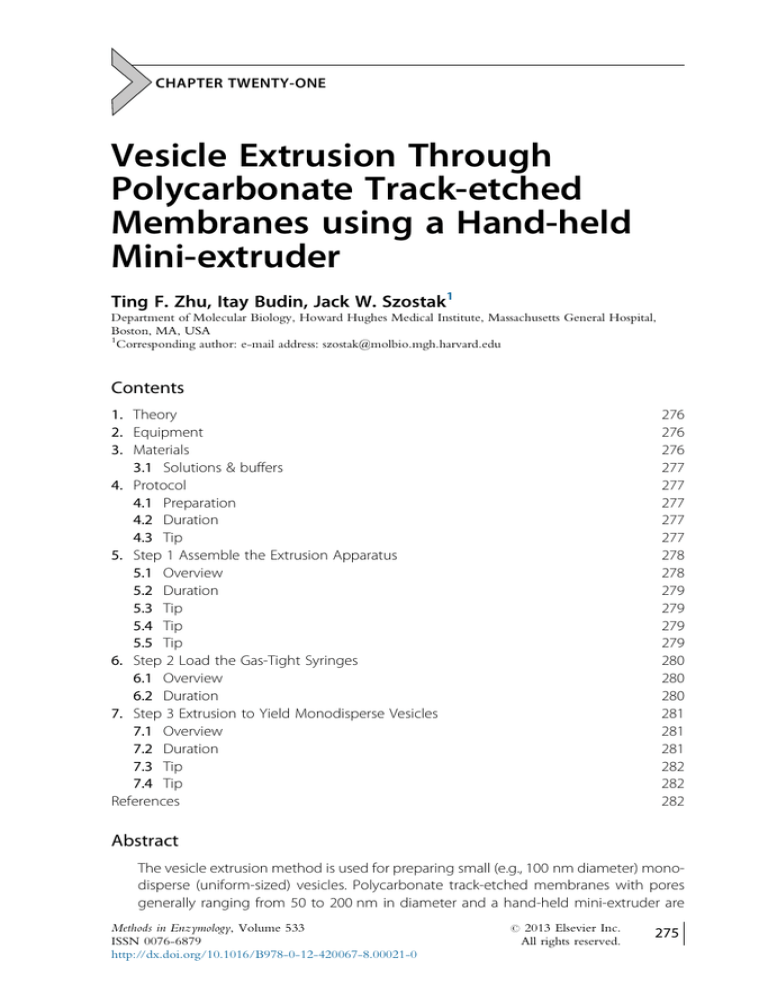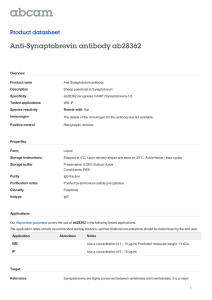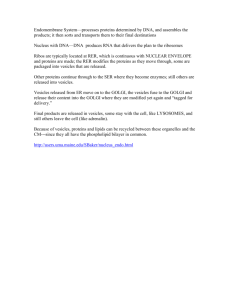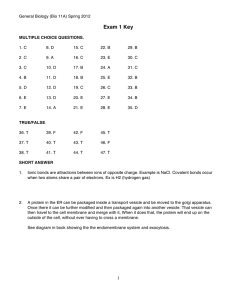
CHAPTER TWENTY-ONE
Vesicle Extrusion Through
Polycarbonate Track-etched
Membranes using a Hand-held
Mini-extruder
Ting F. Zhu, Itay Budin, Jack W. Szostak1
Department of Molecular Biology, Howard Hughes Medical Institute, Massachusetts General Hospital,
Boston, MA, USA
1
Corresponding author: e-mail address: szostak@molbio.mgh.harvard.edu
Contents
1. Theory
2. Equipment
3. Materials
3.1 Solutions & buffers
4. Protocol
4.1 Preparation
4.2 Duration
4.3 Tip
5. Step 1 Assemble the Extrusion Apparatus
5.1 Overview
5.2 Duration
5.3 Tip
5.4 Tip
5.5 Tip
6. Step 2 Load the Gas-Tight Syringes
6.1 Overview
6.2 Duration
7. Step 3 Extrusion to Yield Monodisperse Vesicles
7.1 Overview
7.2 Duration
7.3 Tip
7.4 Tip
References
276
276
276
277
277
277
277
277
278
278
279
279
279
279
280
280
280
281
281
281
282
282
282
Abstract
The vesicle extrusion method is used for preparing small (e.g., 100 nm diameter) monodisperse (uniform-sized) vesicles. Polycarbonate track-etched membranes with pores
generally ranging from 50 to 200 nm in diameter and a hand-held mini-extruder are
Methods in Enzymology, Volume 533
ISSN 0076-6879
http://dx.doi.org/10.1016/B978-0-12-420067-8.00021-0
#
2013 Elsevier Inc.
All rights reserved.
275
276
Ting F. Zhu et al.
used for such a procedure. Extrusion through small (100 nm in diameter or smaller)
pores also ensures that the vesicle population is predominantly unilamellar.
1. THEORY
The vesicle extrusion method takes advantage of the fact that when
vesicles are forced through membrane pores smaller than their diameter,
they break down into smaller vesicles closer to the pore size (see
Video 1). http://dx.doi.org/10.1016/B978-0-12-420067-8.00021-0. Vesicle extrusion has also been used as a laboratory method to induce protocell
division (Hanczyc et al., 2003).
2. EQUIPMENT
Hand-held mini-extruder (http://www.ncnr.nist.gov/userlab/pdf/
E134extruder.pdf)
Two gas-tight syringes (often come with an extruder)
pH meter
1.5-ml microcentrifuge tubes
Polycarbonate track-etched membranes, either 13 or 25 mM in diameter
(http://www.whatman.com/NucleporeTrackEtchedMembranes.aspx)
10-mm filter supports (http://avantilipids.com/index.php?option¼com_
content&view¼article&id¼522&Itemid¼293&catnumber¼610014)
3. MATERIALS
1-Palmitoyl-2-oleoyl-sn-glycero-3-phosphocholine (POPC) (or any
phospholipid of choice)
Oleic acid (or any fatty acid of choice)
LissamineTMrhodamine
B
1,2-dihexadecanoyl-sn-glycero-3phosphoethanolamine (Rh-DHPE) (for fluorescent membrane labeling,
if desired)
Bicine (or other buffer of choice, except borate or phosphate buffer,
which produces leaky fatty acid vesicles)
8-Hydroxypyrene-1,3,6-trisulfonic acid trisodium salt (HPTS, or other
water-soluble fluorescent dye of choice)
Sodium hydroxide (NaOH)
Chloroform
Methanol
Deionized water
277
Vesicle Extrusion Through Polycarbonate Track-etched Membranes
3.1. Solutions & buffers
Preparation 1-M Na-bicine, pH 8.5
Dissolve 163.2-g bicine in 800-ml deionized water. Adjust pH to 8.5 using NaOH.
Add water to 1l
100-mM HPTS
Dissolve 52.4-mg HPTS in 1-ml deionized water
Na-bicine buffer þ HPTS
Component
Final concentration
Stock
Amount
Na-bicine, pH 8.5
200 mM
1M
1 ml
HPTS
2 mM
100 mM
0.1 ml
Add water to 5 ml
Step 1 Na-bicine buffer
Component
Final concentration
Stock
Amount
Na-bicine, pH 8.5
200 mM
1M
1 ml
Add water to 5 ml
4. PROTOCOL
4.1. Preparation
Prepare vesicles by suspending lipid(s) in a buffer solution (see Preparation of
fatty acid or phospholipid vesicles by thin-film rehydration).
4.2. Duration
Preparation
About 1 day
Protocol
About 50 Min
4.3. Tip
If using photosensitive lipids, avoid exposure to light by wrapping aluminum foil
around the flask containing the vesicles. Avoid exposure to oxygen by flushing the
container with argon or nitrogen gas.
See Fig. 21.1 for the flowchart of the complete protocol.
278
Ting F. Zhu et al.
Figure 21.1 Flowchart of the complete protocol, including preparation.
Figure 21.2 Hand-held mini-extruder with two gas-tight syringes.
5. STEP 1 ASSEMBLE THE EXTRUSION APPARATUS
5.1. Overview
Assemble the extrusion apparatus with the polycarbonate track-etched
membranes and filter supports (Fig. 21.2 and Video 2). http://dx.doi.
org/10.1016/B978-0-12-420067-8.00021-0.
Vesicle Extrusion Through Polycarbonate Track-etched Membranes
279
5.2. Duration
5 Min
1.1 Prewet the polycarbonate track-etched membranes of choice (e.g.,
with 100-nm diameter pores) and the filter supports.
1.2 Put one filter support on each side of the two internal membrane supports (white plastic parts), with the prewetted polycarbonate tracketched membrane on top. Assemble the rest of the parts of the extrusion
apparatus (Fig. 21.3 & 21.4).
5.3. Tip
Rinse the extruder parts with water before assembly.
5.4. Tip
When prewetting the polycarbonate track-etched membranes and filter supports, rapidly dip the membranes or filter supports into the same buffer used for preparing
vesicles.
5.5. Tip
One can choose to double the polycarbonate track-etched membrane to prevent membrane rupture, especially when using high pressure for extrusion.
Figure 21.3 Assembly of the extrusion apparatus. On each internal membrane support
(white plastic part with a black O-ring) there is a filter support, with a polycarbonate
track-etched membrane on top.
280
Ting F. Zhu et al.
Figure 21.4 Assembly of the internal membrane support parts with filter support and
polycarbonate track-etched membrane in the middle.
6. STEP 2 LOAD THE GAS-TIGHT SYRINGES
6.1. Overview
Load the gas-tight syringes with vesicle sample.
6.2. Duration
5 Min
2.1 Rinse the syringes with water and then the same buffer used for preparing vesicles.
2.2 Load one of the gas-tight syringes with the vesicle sample in a volume
between 0.5 and 1 ml. See Video 3. http://dx.doi.org/10.1016/B9780-12-420067-8.00021-0.
Vesicle Extrusion Through Polycarbonate Track-etched Membranes
281
7. STEP 3 EXTRUSION TO YIELD MONODISPERSE
VESICLES
7.1. Overview
Force the vesicles in the two gas-tight syringes back and forth through the
hand-held mini-extruder 11 times. See Video 4. http://dx.doi.org/10.
1016/B978-0-12-420067-8.00021-0.
7.2. Duration
10 Min
3.1 Lock the gas-tight syringes in place on the hand-held mini-extruder.
3.2 Slowly push one syringe, so that all the solution in it goes through the
hand-held mini-extruder to the other side, into the other syringe
(Fig. 21.5).
3.3 Push from the other side using the other syringe. Repeat this 11 times
through the filter, and collect the final product vesicles. See Video 5.
http://dx.doi.org/10.1016/B978-0-12-420067-8.00021-0.
Figure 21.5 Slowly push one syringe (left), so that all the solution in it goes through the
hand-held mini-extruder to the other side, into the other syringe (right).
282
Ting F. Zhu et al.
7.3. Tip
For larger pore sizes (>100 nm), slowly push the syringe at a constant rate of
1 ml Min1. Extrusion at higher flow rates may lead to excessive disruption of vesicles (Hanczyc et al., 2003).
7.4. Tip
Make sure that the final product vesicles are collected from the syringe that was not
initially loaded with the vesicle sample.
REFERENCES
Referenced Literature
Hanczyc, M. M., Fujikawa, S. M., & Szostak, J. W. (2003). Experimental models of primitive
cellular compartments: Encapsulation, growth, and division. Science, 302(5645),
618–622.
Related Literature
Chen, I. A., Roberts, R. W., & Szostak, J. W. (2004). The emergence of competition
between model protocells. Science, 305(5689), 1474–1476.
Hope, M. J., Bally, M. B., Webb, G., & Cullis, P. R. (1985). Production of large unilamellar
vesicles by a rapid extrusion procedure. Biochimica et Biophysica Acta (BBA) –
Biomembranes. Characterization of size distribution, trapped volume and ability to maintain
a membrane potential, 812(1), 55–65.
Referenced Protocols in Methods Navigator
Preparation of fatty acid or phospholipid vesicles by thin-film rehydration.






